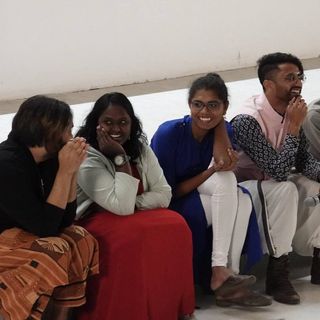
Urban Women Spend 312 Minutes a Day in Unpaid Carework; Men Spend 29
Oxfam report highlights India’s deep gender inequality.

A new Oxfam report reveals urban Indian women spend 312 minutes each day on unpaid carework — everything from cooking to cleaning to child and elder care — while urban men spend only 29. (Rural women spend 291 minutes versus rural men’s 32 minutes.) If paid, this carework that Indian women do would equal roughly 3.1% of the country’s GDP.
It’s a case study of gender inequality that threatens to get lost amid the clatter to refute the report’s calculations of global wealth distribution. What’s important is the report’s conclusion: women and girls are most disadvantaged by an unequal world.
Related on The Swaddle:
Many discussions around women’s empowerment in India include exhortations for women to throw off backwards mindsets and have the confidence to claim equal lifestyles, whether in the home or in the office. This is simplistic to the point of absurd; at best, it contributes to Indian women being the most stressed in the world — at worst, it overlooks the fact that many women live in fear of physical harm should they challenge patriarchal norms. An India-specific supplement to the Oxfam report included the results of a survey of 1,000 households across Bihar, Jharkhand, Chhattisgarh, and Uttar Pradesh, where:
- 54% of households say it’s acceptable to beat a woman if she leaves the house without asking.
- 33% say it is acceptable to beat a woman if she did not care well for the family’s children.
- 36% say it is acceptable to beat a woman if she left an ill family member unattended.
- 41% say it is acceptable to beat a woman if she does not prepare a meal for the men in the family.
- 42% say it is acceptable to beat a woman if she does not gather water or fuelwood for her family.
In addition to these attitudes and threats to their safety, families often lack access to the kinds of public services that would alleviate the burden of unpaid carework that falls on women. In India, there are 0.7 doctors for every 1,000 patients (per 2012 figures); with little access to health care, there is more ill health and more at-home care required, which women are held responsible for. In low-income countries, women’s unpaid contribution to the health sector alone is roughly equal to 3% of GDP.
Even when families do have access to public services, like government education, attitudes that favor investment in boys prevail; data show while the gender gap in enrollment in government schools is narrowing, it’s widening within India’s private schools.
The result is, Indian women have fewer opportunities for paid work, keeping the female labor force participation rates low and falling — from 34.1% in 1999-00 to less than 27% today. (Some recent estimates put it closer to 10%.)
Women who do manage work, earn less: “As per the latest available data (for the year 2011-12), the Gender Pay Gap was 34%, that is, women are still receiving 34% less wages than their male counterparts for carrying out the same work,” the supplement stated. With less money to invest, combined with low financial literacy among even women who do have money of their own, women hold a disproportionately low percentage (between 20 and 30%) of the country’s wealth. This gender wealth gap reaches the very top: Out of 119 billionaires in India, only nine are women.
Related on The Swaddle:
What It Really Takes to Retain Indian Women in the Workforce
It’s worth noting, however, that while gender inequity is present at every socio-economic level, poor and socially disadvantaged women have it the worst. With less social and financial capital, they have fewer resources at their disposal. No where is this clearer than in the following statistics, cited in the Oxfam report and supplement
- In India, girls belonging to rich families (top 20%) get on an average nine years of education, while girls from poor families (bottom 20%) get none at all.
- A lower-caste woman can expect to live almost 15 years less than an upper-caste woman.
The report does outline a way forward, mainly through the ensured provision of public services — from greater funding of health care and education, and social protection schemes, to effective implementation through proper staffing and a bottom-up approach to planning. One of the recommendations, — rethinking ‘work’ to include domestic work as an economic activity — is on the horizon; last year, the government announced plans to conduct the first national survey of unpaid care work within households.
Many of the schemes and systems the report recommends exist in India on paper — if not in implementation. For the most part, India faces the problem of getting it right in practice. But, let’s not kid ourselves — that’s a big problem to have. And if recent news about Beti Bachao, Beti Padhao is any indication, we’re nowhere close to solving it.
Liesl Goecker is The Swaddle's managing editor.
Related


Know Your Rights: Adoption In India
